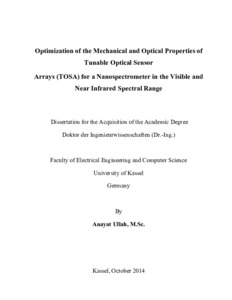| dc.date.accessioned | 2015-01-07T10:51:42Z | |
| dc.date.available | 2015-01-07T10:51:42Z | |
| dc.date.issued | 2015-01-07 | |
| dc.identifier.uri | urn:nbn:de:hebis:34-2015010747030 | |
| dc.identifier.uri | http://hdl.handle.net/123456789/2015010747030 | |
| dc.language.iso | eng | |
| dc.rights | Urheberrechtlich geschützt | |
| dc.rights.uri | https://rightsstatements.org/page/InC/1.0/ | |
| dc.subject | Spectroscopy | eng |
| dc.subject | Tunable optical filter | eng |
| dc.subject | Fabry Pérot | eng |
| dc.subject | MEMS | eng |
| dc.subject | Sputter deposition | eng |
| dc.subject | Niobium pentoxide | eng |
| dc.subject | Silicon dioxide | eng |
| dc.subject | Residual stress | eng |
| dc.subject.ddc | 620 | |
| dc.title | Optimization of the Mechanical and Optical Properties of Tunable Optical Sensor Arrays (TOSA) for a Nanospectrometer in the Visible and Near Infrared Spectral Range | eng |
| dc.type | Dissertation | |
| dcterms.abstract | Tunable Optical Sensor Arrays (TOSA) based on Fabry-Pérot (FP) filters, for high quality spectroscopic applications in the visible and near infrared spectral range are investigated within this work. The optical performance of the FP filters is improved by using ion beam sputtered niobium pentoxide (Nb2O5) and silicon dioxide (SiO2) Distributed Bragg Reflectors (DBRs) as mirrors. Due to their high refractive index contrast, only a few alternating pairs of Nb2O5 and SiO2 films can achieve DBRs with high reflectivity in a wide spectral range, while ion beam sputter deposition (IBSD) is utilized due to its ability to produce films with high optical purity. However, IBSD films are highly stressed; resulting in stress induced mirror curvature and suspension bending in the free standing filter suspensions of the MEMS (Micro-Electro-Mechanical Systems) FP filters. Stress induced mirror curvature results in filter transmission line degradation, while suspension bending results in high required filter tuning voltages. Moreover, stress induced suspension bending results in higher order mode filter operation which in turn degrades the optical resolution of the filter. Therefore, the deposition process is optimized to achieve both near zero absorption and low residual stress. High energy ion bombardment during film deposition is utilized to reduce the film density, and hence the film compressive stress. Utilizing this technique, the compressive stress of Nb2O5 is reduced by ~43%, while that for SiO2 is reduced by ~40%. Filters fabricated with stress reduced films show curvatures as low as 100 nm for 70 μm mirrors. To reduce the stress induced bending in the free standing filter suspensions, a stress optimized multi-layer suspension design is presented; with a tensile stressed metal sandwiched between two compressively stressed films. The stress in Physical Vapor Deposited (PVD) metals is therefore characterized for use as filter top-electrode and stress compensating layer. Surface micromachining is used to fabricate tunable FP filters in the visible spectral range using the above mentioned design. The upward bending of the suspensions is reduced from several micrometers to less than 100 nm and 250 nm for two different suspension layer combinations. Mechanical tuning of up to 188 nm is obtained by applying 40 V of actuation voltage. Alternatively, a filter line with transmission of 65.5%, Full Width at Half Maximum (FWHM) of 10.5 nm and a stopband of 170 nm (at an output wavelength of 594 nm) is achieved. Numerical model simulations are also performed to study the validity of the stress optimized suspension design for the near infrared spectral range, wherein membrane displacement and suspension deformation due to material residual stress is studied. Two bandpass filter designs based on quarter-wave and non-quarter-wave layers are presented as integral components of the TOSA. With a filter passband of 135 nm and a broad stopband of over 650 nm, high average filter transmission of 88% is achieved inside the passband, while maximum filter transmission of less than 1.6% outside the passband is achieved. | ger |
| dcterms.accessRights | open access | |
| dcterms.alternative | Optimierung der mechanischen und optischen Eigenschaften von durchstimmbaren optischen Sensor Arrays für ein Nanospektrometer im sichtbaren und nah-infraroten Spektralbereich | ger |
| dcterms.creator | Ullah, Anayat | |
| dc.contributor.corporatename | Kassel, Universität Kassel, Fachbereich Elektrotechnik/Informatik | |
| dc.contributor.referee | Hillmer, Hartmut (Prof. Dr.) | |
| dc.contributor.referee | Bangert, Axel (Prof. Dr.) | |
| dc.subject.swd | Spektroskopie | ger |
| dc.subject.swd | Sensor-Array | ger |
| dc.subject.swd | Optisches Filter | ger |
| dc.subject.swd | Niobpentoxid | ger |
| dc.subject.swd | Siliciumdioxid | ger |
| dc.date.examination | 2014-12-11 | |

